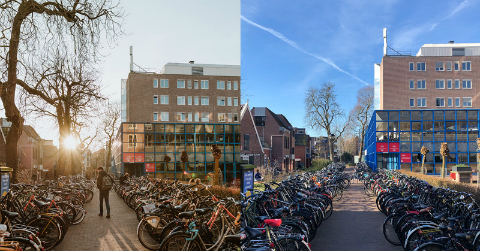This weekend, five chestnut trees that used to stand outside the Harmony Building were cut down to stumps. According to the international carbon testing program iTreeTools, these five trees – which had a circumference of 300 centimetres – sequestered nearly 500 kg of CO2 per year, intercepted 1600 litres of storm water, and stored a combined 16,000 life-time equivalent of CO2, which will now be released into the atmosphere as carbon and other greenhouse gases.
Only a few years earlier, these trees were ‘topped’: all of their upper crowns were removed. No arborist would ever recommend topping a tree. Doing so forces the tree into starvation mode.
When all of the foliage is removed in a single pruning, the trees will produce extra fast growth in weakly protruding shoots in order to produce enough food via photosynthesis for the next growing season. Excessive pruning also results in top heavy trees which are susceptible to the ‘turbine effect’ during high winds.
Topping reduces the long-term life span of mature trees and increases their potential for failure. Disturbing the balance between the roots and the crown stimulates rot in the roots and, eventually, in the trunk, which makes trees prone to falling. Finally, fewer living branches leads to further architectural instability, especially during storms.
Lion’s tailing
I recently witnessed a terribly destructive crown raising behind the Academy building. A notorious technique – called ‘lion’s tailing’ – resulted in top-heavy trees: all the lower and inner branches were removed, leading to long branches with leaves only at the tail of the branch – like a lion’s tail.
This technique is internationally shunned by tree experts and scientific forestry organizations. I brought this to the attention of the building and green maintenance liaison at the university.
The value of trees
But building and maintenance defended the decision, saying it was done out of fear of falling branches. Irrational fears should not be the basis of our tree maintenance. Rather, it is the job of our green and tree maintenance workers to know best how to facilitate the safety of our urban trees, rather than acting destructively based upon ill-advised requests from non-tree experts.
All of these mature trees near the Harmony and the Academy building have now been so aggressively trimmed that their life spans have been drastically reduced. Yet we all know the value of trees in the urban environment – they produce the oxygen we breathe, improve our mental health, are aesthetically beautiful, fight climate change (through carbon and other greenhouse gas sequestration), filter pollution, filter storm water, and are home to birds, insects, and bats.
They also remind us of the changing of the seasons and keep us linked to the natural environment in spite of our concrete jungle.
Be a leader towards a more sustainable future
That the university carelessly trims and removes so many trees is a sign of our own failure to understand how dependent we are upon especially large-stature trees for our survival. Too often fears of falling trees, or misinformed beliefs that trees have reached the end of their life spans, leads to premature felling.
We at Bomenridders Groningen request that the university take its role seriously as a leader towards a more sustainable future, instead of failing to care for our urban forest properly.
Topping, premature felling, and extreme crown raising all have the same result in the end: loss of the very essential beings that make living and working in the urban environment sustainable, pleasurable, and healthy.
Kristin McGee is Associate Professor of Music in the Arts, Culture and Media Department and Chair of the local tree activist group Bomenridders Groningen.





